When you are out and about, walking off the Turkey and mince pies (and wine), you may wish to keep your eye out for a few winter visitors to The Lizard. As with any season late autumn and early winter brings some different and often wonderful species onto The Lizard. Many species come south, migrating from northern Europe and Russia, to enjoy the balmy climate in Cornwall – these include lots of Song Thrushes, Blackbirds and the less common Redwing and Fieldfare which can often be seen in mixed flocks; in particularly cold spells Redwings and Fieldfares will come into your garden – especially if you have any shrubs or trees with berries.
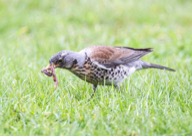 Fieldfare
Fieldfare
The most magnificent berry feeder is the wonderful Waxwing – these come south when it is really cold and are really striking. A friend of mine, that has just relocated from The Lizard area to Fife, sent me this picture last week – they are on their way!
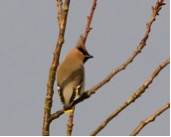 Waxwing – Photo Andy Pay
Waxwing – Photo Andy Pay
Other more common species are much more evident, on The Lizard, than at other times of year due to an influx of migratory species and/or birds coming closer to human habitation in search of food. This time of year is a great opportunity to get familiar with the different Tit species and to separate out the crests.
There are good numbers of both Firecrest and Goldcrest on The Lizard at the moment – these can be found almost anywhere with trees or willows and are often with flocks of Long Tailed or Blue Tits. Firecrests are particularly beautiful – the large white eye stripe and much richer green back are the things to look for when trying to differentiate between Gold and Firecrests.
 Firecrest
Firecrest
There are also lots of migratory birds to look out for near the coast and on the sea; many Gulls come to The Lizard for their winter holidays too. Some come south – Iceland and Glaucous Gulls and others come north – Mediterranean Gulls. Have a look in your bird guide to see the key identifiers for these 3 species. The main one (in all of the adult birds for all 3 species) is that they do not have black wing tips. Store the fact that any Gull without black wing tips is interesting and you have a good place to start! All 3 species can turn up anywhere on The Lizard – good places for Iceland and Glaucous Gulls are Coverack Harbour and bay, Lizard Point or any recently ploughed field (plus Helston Boating Lake – not quite on The Lizard but hey ho). Mediterranean Gulls are often found around the creeks in Gillan/St Anthony and again in ploughed fields.
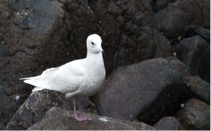 |
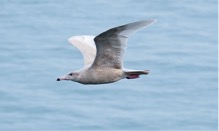 |
| Iceland Gull | Glaucous Gull |
Adult Med Gulls are fairly easy to identify (see above picture for comparison with the much more commom Black Headed Gull). Both the birds above are in winter plumage – the key differences are the lack of black wing tips and bright red, large bill on the Med Gull; however be careful as adult B H Gulls have read bills too – but much thinner and daintier. Younger birds are more difficult to tell apart – that is for a different lesson/day.
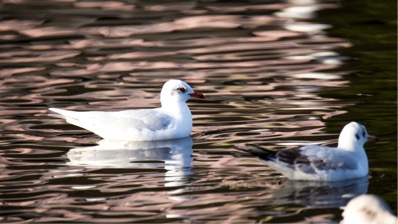
Anyway if you fancy learning more about birds on The Lizard please visit www.cbwps.org.uk and look at the “Walks and Events” tab/page. One of our local volunteers will help out.
Published: Dec 2017
Author: Dougy Wright (Volunteer Warden at Windmill Farm National Nature Reserve)
